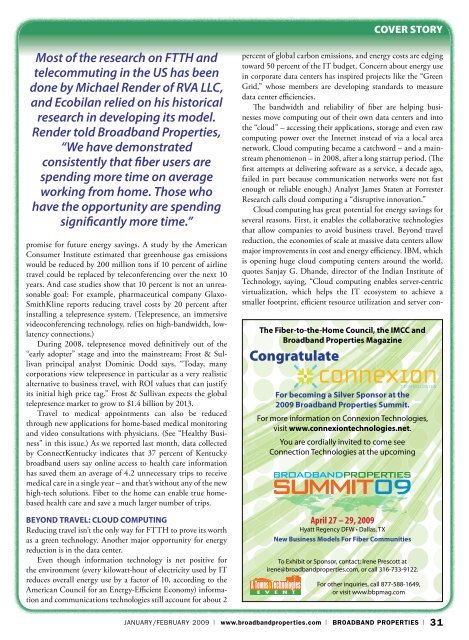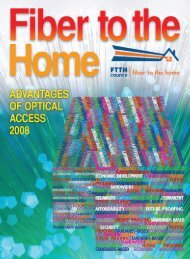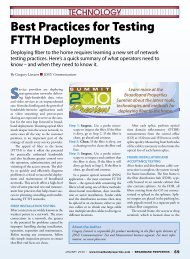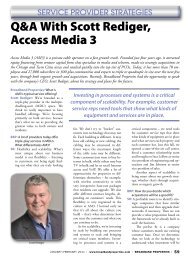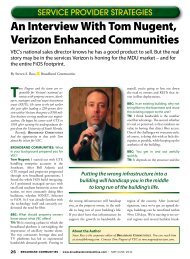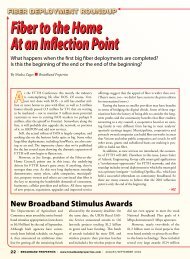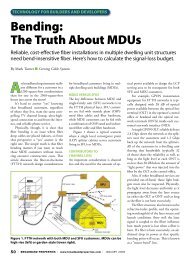bbpmag.com - Broadband Properties
bbpmag.com - Broadband Properties
bbpmag.com - Broadband Properties
You also want an ePaper? Increase the reach of your titles
YUMPU automatically turns print PDFs into web optimized ePapers that Google loves.
cover story<br />
Most of the research on FTTH and<br />
tele<strong>com</strong>muting in the US has been<br />
done by Michael Render of RVA LLC,<br />
and Ecobilan relied on his historical<br />
research in developing its model.<br />
Render told <strong>Broadband</strong> <strong>Properties</strong>,<br />
“We have demonstrated<br />
consistently that fiber users are<br />
spending more time on average<br />
working from home. Those who<br />
have the opportunity are spending<br />
significantly more time.”<br />
promise for future energy savings. A study by the American<br />
Consumer Institute estimated that greenhouse gas emissions<br />
would be reduced by 200 million tons if 10 percent of airline<br />
travel could be replaced by teleconferencing over the next 10<br />
years. And case studies show that 10 percent is not an unreasonable<br />
goal: For example, pharmaceutical <strong>com</strong>pany Glaxo-<br />
SmithKline reports reducing travel costs by 20 percent after<br />
installing a telepresence system. (Telepresence, an immersive<br />
videoconferencing technology, relies on high-bandwidth, lowlatency<br />
connections.)<br />
During 2008, telepresence moved definitively out of the<br />
“early adopter” stage and into the mainstream; Frost & Sullivan<br />
principal analyst Dominic Dodd says, “Today, many<br />
corporations view telepresence in particular as a very realistic<br />
alternative to business travel, with ROI values that can justify<br />
its initial high price tag.” Frost & Sullivan expects the global<br />
telepresence market to grow to $1.4 billion by 2013.<br />
Travel to medical appointments can also be reduced<br />
through new applications for home-based medical monitoring<br />
and video consultations with physicians. (See “Healthy Business”<br />
in this issue.) As we reported last month, data collected<br />
by ConnectKentucky indicates that 37 percent of Kentucky<br />
broadband users say online access to health care information<br />
has saved them an average of 4.2 unnecessary trips to receive<br />
medical care in a single year – and that’s without any of the new<br />
high-tech solutions. Fiber to the home can enable true homebased<br />
health care and save a much larger number of trips.<br />
Beyond Travel: Cloud Computing<br />
Reducing travel isn’t the only way for FTTH to prove its worth<br />
as a green technology. Another major opportunity for energy<br />
reduction is in the data center.<br />
Even though information technology is net positive for<br />
the environment (every kilowatt-hour of electricity used by IT<br />
reduces overall energy use by a factor of 10, according to the<br />
American Council for an Energy-Efficient Economy) information<br />
and <strong>com</strong>munications technologies still account for about 2<br />
percent of global carbon emissions, and energy costs are edging<br />
toward 50 percent of the IT budget. Concern about energy use<br />
in corporate data centers has inspired projects like the “Green<br />
Grid,” whose members are developing standards to measure<br />
data center efficiencies.<br />
The bandwidth and reliability of fiber are helping businesses<br />
move <strong>com</strong>puting out of their own data centers and into<br />
the “cloud” – accessing their applications, storage and even raw<br />
<strong>com</strong>puting power over the Internet instead of via a local area<br />
network. Cloud <strong>com</strong>puting became a catchword – and a mainstream<br />
phenomenon – in 2008, after a long startup period. (The<br />
first attempts at delivering software as a service, a decade ago,<br />
failed in part because <strong>com</strong>munication networks were not fast<br />
enough or reliable enough.) Analyst James Staten at Forrester<br />
Research calls cloud <strong>com</strong>puting a “disruptive innovation.”<br />
Cloud <strong>com</strong>puting has great potential for energy savings for<br />
several reasons. First, it enables the collaborative technologies<br />
that allow <strong>com</strong>panies to avoid business travel. Beyond travel<br />
reduction, the economies of scale at massive data centers allow<br />
major improvements in cost and energy efficiency. IBM, which<br />
is opening huge cloud <strong>com</strong>puting centers around the world,<br />
quotes Sanjay G. Dhande, director of the Indian Institute of<br />
Technology, saying, “Cloud <strong>com</strong>puting enables server-centric<br />
virtualization, which helps the IT ecosystem to achieve a<br />
smaller footprint, efficient resource utilization and server con-<br />
The Fiber-to-the-Home Council, the IMCC and<br />
<strong>Broadband</strong> <strong>Properties</strong> Magazine<br />
Congratulate<br />
For be<strong>com</strong>ing a Silver Sponsor at the<br />
2009 <strong>Broadband</strong> <strong>Properties</strong> Summit.<br />
For more information on Connexion Technologies,<br />
visit www.connexiontechnologies.net.<br />
You are cordially invited to <strong>com</strong>e see<br />
Connection Technologies at the up<strong>com</strong>ing<br />
April 27 – 29, 2009<br />
Hyatt Regency DFW • Dallas, TX<br />
New Business Models For Fiber Communities<br />
To Exhibit or Sponsor, contact: Irene Prescott at<br />
irene@broadbandproperties.<strong>com</strong>, or call 316-733-9122.<br />
& For other inquiries, call 877-588-1649,<br />
or visit www.<strong>bbpmag</strong>.<strong>com</strong><br />
January/February 2009 | www.broadbandproperties.<strong>com</strong> | BROADBAND PROPERTIES | 31


